unit3
- 格式:pdf
- 大小:34.17 KB
- 文档页数:4
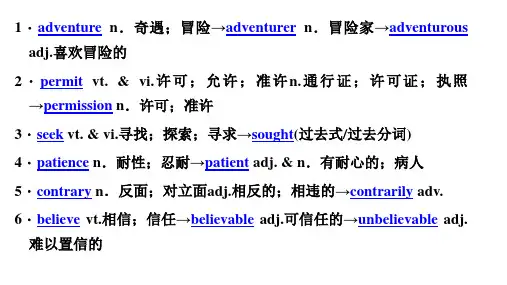
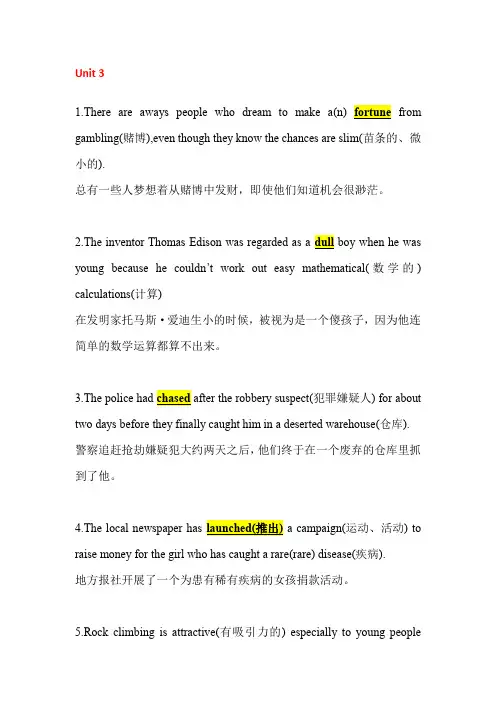
Unit 31.There are aways people who dream to make a(n) from gambling(赌博),even though they know the chances are slim(苗条的、微小的).总有一些人梦想着从赌博中发财,即使他们知道机会很渺茫。
young because he couldn’t work out easy mathematical(数学的) calculations(计算)在发明家托马斯·爱迪生小的时候,被视为是一个傻孩子,因为他连简单的数学运算都算不出来。
犯罪嫌疑人) for about two days before they finally caught him in a deserted warehouse(仓库).警察追赶抢劫嫌疑犯大约两天之后,他们终于在一个废弃的仓库里抓到了他。
运动、活动) to raise money for the girl who has caught a rare(rare) disease(疾病).地方报社开展了一个为患有稀有疾病的女孩捐款活动。
5.Rock climbing is attractive(有吸引力的) especially to young peoplebecause it is always with hardship(困难) and adventure.攀岩是具有吸引力的,尤其是对年轻人来说,因为它总是伴随着困难和冒险。
6.The face value(面值) of the bill(账单、钞票(内在的) value is nothing but that of a piece of paper.该票据面值为一美元,但其内在价值只是一张纸。
7.Having won several championships in international matches recently,hecurrently(目前among the world’s professional tennis players.在最近的国际比赛中赢得了几次冠军,他目前在世界上职业网球选手中排名第二。
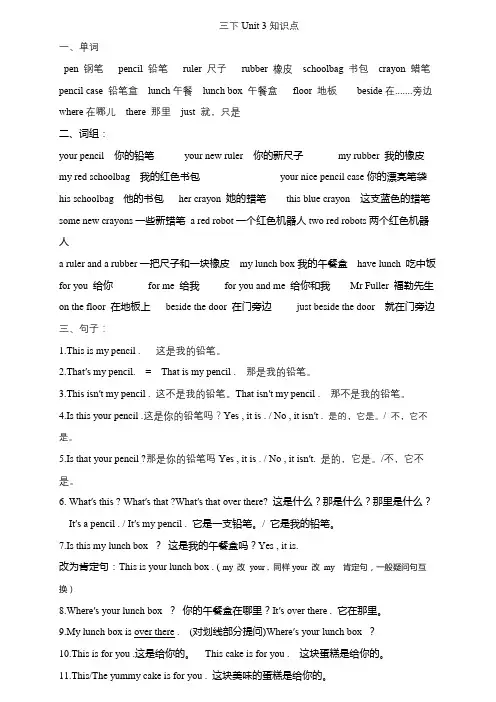
三下Unit 3知识点一、单词pen 钢笔pencil 铅笔ruler 尺子rubber 橡皮schoolbag 书包crayon 蜡笔pencil case 铅笔盒lunch午餐lunch box 午餐盒floor 地板beside在.......旁边where在哪儿there 那里just 就,只是二、词组:your pencil 你的铅笔your new ruler 你的新尺子my rubber 我的橡皮my red schoolbag 我的红色书包your nice pencil case你的漂亮笔袋his schoolbag 他的书包her crayon 她的蜡笔this blue crayon 这支蓝色的蜡笔some new crayons一些新蜡笔a red robot一个红色机器人two red robots两个红色机器人a ruler and a rubber一把尺子和一块橡皮my lunch box我的午餐盒have lunch 吃中饭for you 给你for me 给我for you and me 给你和我Mr Fuller 福勒先生on the floor 在地板上beside the door 在门旁边just beside the door 就在门旁边三、句子:1.This is my pencil .这是我的铅笔。
2.That′s my pencil. = That is my pencil . 那是我的铅笔。
3.This isn′t my pencil . 这不是我的铅笔。
That isn′t my pencil . 那不是我的铅笔。
4.Is this your pencil .这是你的铅笔吗?Yes , it is . / No , it isn′t . 是的,它是。
/ 不,它不是。
5.Is that your pencil ?那是你的铅笔吗Yes , it is . / No , it isn′t. 是的,它是。
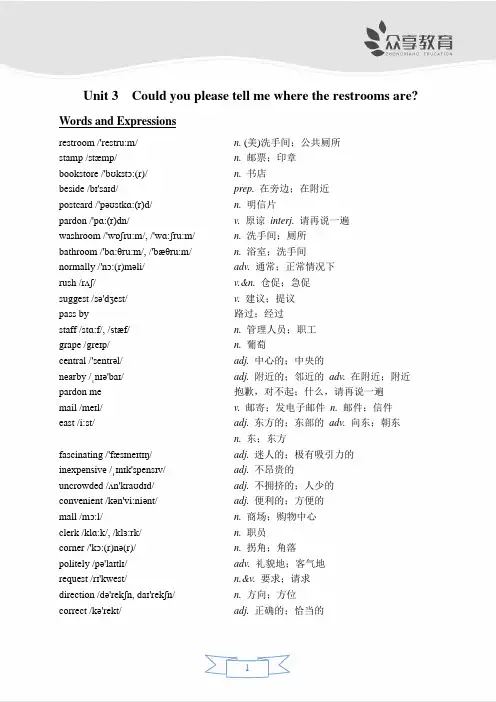
Unit 3 Could you please tell me where the restrooms are? Words and Expressionsrestroom /'restru:m/ n. (美)洗手间;公共厕所stamp /stæmp/ n.邮票;印章bookstore /'bʊkstɔ:(r)/ n.书店beside /bɪ'saɪd/ prep.在旁边;在附近postcard /'pəʊstkɑ:(r)d/ n.明信片pardon /'pɑ:(r)dn/ v.原谅interj.请再说一遍washroom /'wɒʃru:m/, /'wɑ:ʃru:m/ n.洗手间;厕所bathroom /'bɑ:θru:m/, /'bæθru:m/ n.浴室;洗手间normally /'nɔ:(r)məli/ adv.通常;正常情况下rush /rʌʃ/ v.&n.仓促;急促suggest /sə'dʒest/ v.建议;提议pass by 路过;经过staff /stɑ:f/, /stæf/ n.管理人员;职工grape /greɪp/ n.葡萄central /'sentrəl/ adj.中心的;中央的nearby /ˌnɪə'baɪ/ adj.附近的;邻近的adv.在附近;附近pardon me 抱歉,对不起;什么,请再说一遍mail /meɪl/ v.邮寄;发电子邮件n.邮件;信件east /i:st/ adj.东方的;东部的adv.向东;朝东n.东;东方fascinating /'fæsɪneɪtɪŋ/ adj.迷人的;极有吸引力的inexpensive /ˌɪnɪk'spensɪv/ adj.不昂贵的uncrowded /ʌn'kraʊdɪd/ adj.不拥挤的;人少的convenient /kən'vi:niənt/ adj.便利的;方便的mall /mɔ:l/ n. 商场;购物中心clerk /klɑ:k/, /klɜ:rk/ n. 职员corner /'kɔ:(r)nə(r)/ n. 拐角;角落politely /pə'laɪtlɪ/ adv. 礼貌地;客气地request /rɪ'kwest/ n.&v. 要求;请求direction /də'rekʃn, daɪ'rekʃn/ n. 方向;方位correct /kə'rekt/ adj. 正确的;恰当的polite /pə'laɪt/ adj. 有礼貌的;客气的direct /də'rek, daɪ'rek / adj.直接的;直率的speaker /'spi:kə(r)/ n. 讲(某种语言)的人;发言者whom /hu:m/ pron. 谁;什么人impolite /'ɪmpə'laɪt/ adj. 不礼貌的;粗鲁的address /ə'dre/, /'ædres/ n.住址;地址;通讯处underground /'ʌndə(r)graʊnd/ adj.地下的n.地铁parking lot 停车场;停车区course /kɔ:(r)s/ n.课程;学科Italian /ɪ'tælɪən/ adj.意大利(人)的n. 意大利人;意大利语Tim /tɪm/ 蒂姆(男名)Role-play the conversation.He Wei: This is Fun Times Park, the biggest amusementpark in our city!Alice: I’m excited to try the rides!He Wei: Where should we start with? There’s SpaceWorld, Water World, Animal World...Alice: Before we decide, could you first tell me wherethe restrooms are?He Wei: Pardon? Restroom? You want to rest? But we haven’t even started yet!Alice: Oh no, I don’t mean that. I mean ... you know, a washroom or bathroom.He Wei: Hmm ... so you mean ... the toilet?Alice: Yes! Sorry, maybe people in China don’t often use th e word “restroom”when they speak English.He Wei: That’s right. In China, we normally say “toilet”or “washroom” in English. Anyway, t hey’re over there.Alice: OK. I’ll be quick!He Wei: No problem. Y ou don’t need to rush!Reading 1Read the conversation and answer the questions below.1. Why did Alice not want to go on the new ride? How did she feel after the ride?2. What is special about Uncle Bob’s restaurant? Should Alice and He Wei get there early for dinner? Why?Fun Times Park — Always a Fun Time![Alice and He Wei are in Space World.]Alice: I wonder where we should go next.He Wei: How about that new ride over there?Alice: Well ... it looks scary.He Wei: Come on! I promise it’ll be exciting! If you’re scared, just shout or hold my hand. [After the ride…]Alice: You were right! That was fun! I was scared at first, but shouting did help.He Wei: See, that wasn’t so bad, right? You never know until you try something.Alice: Yes, I’m so glad I tried it!He Wei: Do you want to go to Water World now?Alice: Sure, but I’m getting hungry. Do you know where we can get some good food quickly?He Wei: Of course! I suggest Water City Restaurant in Water World. It serves delicious food. Alice: Great! Let’s go![On their way to Water City Restaurant, Alice and He Wei pass by Uncle Bob’s.]Alice: Look! This restaurant looks interesting. The sign says a rock band plays here every evening.He Wei: Why don’t we come back here for dinner later? Let’s ask what time t he band starts playing.[Alice and He Wei walk up to a staff person at the door.]He Wei: Excuse me, could you tell us when the band starts playing this evening?Staff: Eight o’clock. The restaurant is always busy at that time, so come a little earlier to geta table.He Wei: OK, thank you!Grammar FocusExcuse me, do you know where I can buy some medicine? Sure. There’s a supermarket down the street.Could you please tell me how to get to the post office? Sorry, I’m not sure how to getthere.Can you tell us when the band starts playing thisevening?It starts at 8:00 p.m.I wonder where we should go next. You should try that new ride overthere.语法小结:一、礼貌用语Excuse me, do you know…Could you please tell me…I wonder…Please tell me…Pardon me,…I’d like to know…Have you any idea…Would you mind telling me…二、wh-引导的宾语从句I wonder when the park closes today.我想知道这个公园今天什么时候关门。
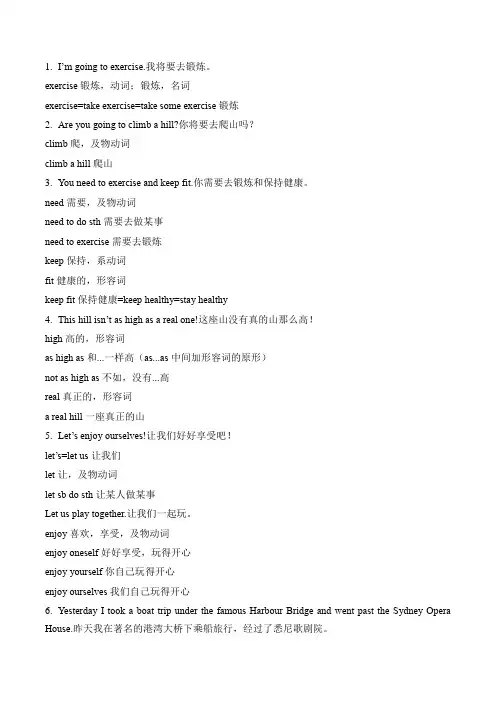
1.I’m going to exercise.我将要去锻炼。
exercise锻炼,动词;锻炼,名词exercise=take exercise=take some exercise锻炼2.Are you going to climb a hill?你将要去爬山吗?climb爬,及物动词climb a hill爬山3.You need to exercise and keep fit.你需要去锻炼和保持健康。
need需要,及物动词need to do sth需要去做某事need to exercise需要去锻炼keep保持,系动词fit健康的,形容词keep fit保持健康=keep healthy=stay healthy4.This hill isn’t as high as a real one!这座山没有真的山那么高!high高的,形容词as high as和...一样高(as...as中间加形容词的原形)not as high as不如,没有...高real真正的,形容词a real hill一座真正的山5.Let’s enjoy ourselves!让我们好好享受吧!let’s=let us让我们let让,及物动词let sb do sth让某人做某事Let us play together.让我们一起玩。
enjoy喜欢,享受,及物动词enjoy oneself好好享受,玩得开心enjoy yourself你自己玩得开心enjoy ourselves我们自己玩得开心6.Yesterday I took a boat trip under the famous Harbour Bridge and went past the Sydney Opera House.昨天我在著名的港湾大桥下乘船旅行,经过了悉尼歌剧院。
trip短途旅行,可数名词take a boat trip乘船旅行under在...的下面under the famous Harbour Bridge在港湾大桥下面go past经过=passthe Sydney Opera House悉尼歌剧院go past the Sydney Opera House=pass the Sydney Opera House经过悉尼歌剧院7.I’m having a great time in Australia!我在澳大利亚玩得很开心!have a great time=have a good time=have a nice time=have a wonderful time玩得很开心8.Take care!保重!care照顾,关怀,名词take care保重take care of...照顾...=look after...take good care of...照顾好=look after...welltake good care of yourself=look after yourself well照顾好你自己9.We’re sitting in a little coffee shop by the River Seine.我们正坐在塞纳河旁边的一个小咖啡馆里面。
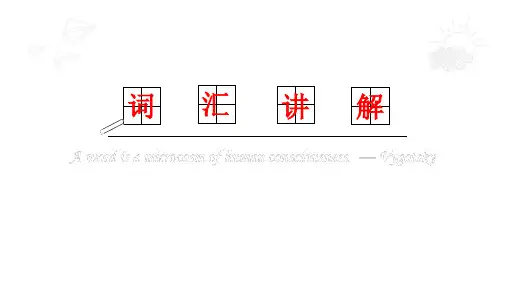
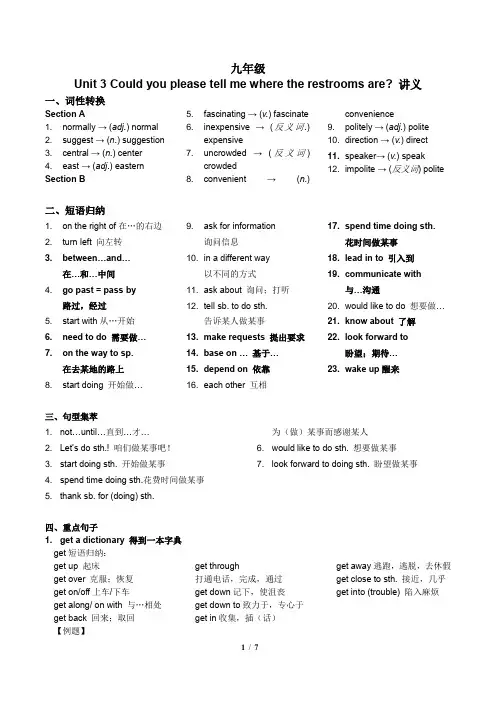
九年级Unit 3 Could you please tell me where the restrooms are? 讲义一、词性转换Section A1. normally → (adj.) normal2. suggest → (n.) suggestion3. central → (n.) center4. east → (adj.) eastern Section B5. fascinating → (v.) fascinate6. inexpensive → (反义词.)expensive7. uncrowded → (反义词)crowded8. convenient → (n.)convenience9. politely → (adj.) polite10. direction → (v.) direct11. speaker→ (v.) speak12. impolite → (反义词) polite二、短语归纳1. on the right of在…的右边2. turn left 向左转3. between…and…在…和…中间4. go past = pass by路过,经过5. start with从…开始6. need to do 需要做…7. on the way to sp.在去某地的路上8. start doing 开始做…9. ask for information询问信息10. in a different way以不同的方式11. ask about 询问;打听12. tell sb. to do sth.告诉某人做某事13. make requests 提出要求14. base on … 基于…15. depend on 依靠16. each other 互相17. spend time doing sth.花时间做某事18. lead in to 引入到19. communicate with与…沟通20. would like to do 想要做…21. know about 了解22. look forward to盼望;期待…23. wake up醒来三、句型集萃1. not…until…直到…才…2. Let’s do sth.! 咱们做某事吧!3. start doing sth. 开始做某事4. spend time doing sth.花费时间做某事5. thank sb. for (doing) sth.为(做)某事而感谢某人6. would like to do sth. 想要做某事7. look forward to doing sth. 盼望做某事四、重点句子1. get a dictionary 得到一本字典get短语归纳:get up 起床get over 克服;恢复get on/off上车/下车get along/ on with 与…相处get back 回来;取回get through打通电话,完成,通过get down记下,使沮丧get down to致力于,专心于get in收集,插(话)get away逃跑,逃脱,去休假get close to sth. 接近,几乎get into (trouble) 陷入麻烦【例题】1. buy a newspaper 买一份报纸buy 为非延续性动词,不能与how long及for引导的表示一段时间的状语连用。
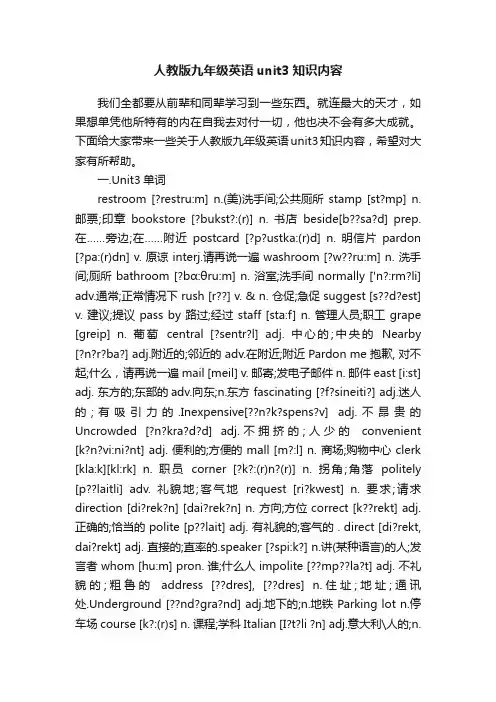
人教版九年级英语unit3知识内容我们全都要从前辈和同辈学习到一些东西。
就连最大的天才,如果想单凭他所特有的内在自我去对付一切,他也决不会有多大成就。
下面给大家带来一些关于人教版九年级英语unit3知识内容,希望对大家有所帮助。
一.Unit3单词restroom [?restru:m] n.(美)洗手间;公共厕所stamp [st?mp] n. 邮票;印章bookstore [?bukst?:(r)] n. 书店beside[b??sa?d] prep. 在……旁边;在……附近postcard [?p?ustka:(r)d] n. 明信片pardon [?pa:(r)dn] v. 原谅 interj.请再说一遍 washroom [?w??ru:m] n. 洗手间;厕所 bathroom [?bɑ:θru:m] n. 浴室;洗手间 normally ['n?:rm?li] adv.通常;正常情况下 rush [r??] v. & n. 仓促;急促 suggest [s??d?est] v. 建议;提议 pass by 路过;经过 staff [sta:f] n. 管理人员;职工 grape [greip] n. 葡萄central [?sentr?l] adj. 中心的;中央的Nearby [?n?r?ba?] adj.附近的;邻近的 adv.在附近;附近 Pardon me 抱歉, 对不起;什么,请再说一遍 mail [meil] v. 邮寄;发电子邮件 n. 邮件 east [i:st] adj. 东方的;东部的adv.向东;n.东方 fascinating [?f?sineiti?] adj.迷人的;有吸引力的.Inexpensive[??n?k?spens?v] adj.不昂贵的Uncrowded [?n?kra?d?d] adj.不拥挤的;人少的convenient [k?n?vi:ni?nt] adj. 便利的;方便的 mall [m?:l] n. 商场;购物中心 clerk [kla:k][kl:rk] n. 职员corner [?k?:(r)n?(r)] n. 拐角;角落politely [p??laitli] adv. 礼貌地;客气地request [ri?kwest] n. 要求;请求direction [di?rek?n] [dai?rek?n] n. 方向;方位 correct [k??rekt] adj. 正确的;恰当的 polite [p??lait] adj. 有礼貌的;客气的 . direct [di?rekt, dai?rekt] adj. 直接的;直率的.speaker [?spi:k?] n.讲(某种语言)的人;发言者 whom [hu:m] pron. 谁;什么人 impolite [??mp??la?t] adj. 不礼貌的;粗鲁的address [??dres], [??dres] n.住址;地址;通讯处.Underground [??nd?ɡra?nd] adj.地下的;n.地铁 Parking lot n.停车场 course [k?:(r)s] n. 课程;学科 Italian [I?t?li ?n] adj.意大利\人的;n.意大利人\语 Tim [tim] 蒂姆(男名)二.Unit3知识梳理【重点短语】1.a pair of 一对,一双,一副2.between A and B 在a和b之间3.on one’s / the way to 在去……的路上4.pardon me 什么,请再说一遍5.pass by 路过经过6.look forward to 盼望期待7.excuse me 打扰了请原谅8.get some information about 获取有关……的一些信息9.turn left\right 向左\向右转10.go past 经过路过11.a little earlier 早一点儿12.a good place to eat 一个吃饭的好地方13.in different situation 在不同的情况下14.on time 准时按时15.get to 到达16.have dinner 吃晚餐17.on one’s / \the right在右边e on 快点请过来19.the shopping center 购物中心20.the corner of....... 的角落/拐角处21.lead into 导入,引入【重点句型】1.问路常用的句子:①Do you know where is … ?②Can you tell me how can I get to …?③Could you tell me how to get to …?④Could/Will/Would you please tell me sth. 表示十分客气地询问事情Could you tell me how to get to the park?请你告诉我怎么才能去邮局好吗?2. decide to do 决定做…...She decided to go to have lunch. 她决定去吃午餐。


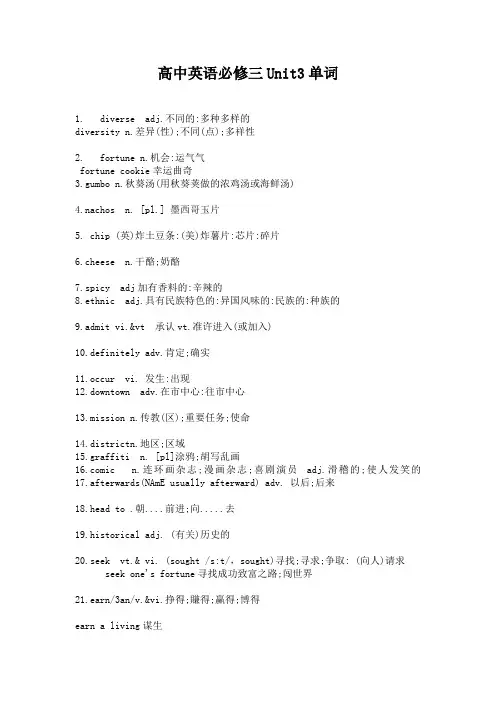
高中英语必修三Unit3单词1. diverse adj.不同的:多种多样的diversity n.差异(性);不同(点);多祥性2. fortune n.机会:运气气fortune cookie幸运曲奇3.gumbo n.秋葵汤(用秋葵荚做的浓鸡汤或海鲜汤)4.nachos n. [pl.] 墨西哥玉片5. chip (英)炸土豆条:(美)炸薯片:芯片:碎片6.cheese n.干酪;奶酪7.spicy adj加有香料的:辛辣的8.ethnic adj.具有民族特色的:异国风味的:民族的:种族的9.admit vi.&vt 承认vt.准许进入(或加入)10.definitely adv.肯定;确实11.occur vi. 发生:出现12.downtown adv.在市中心:往市中心13.mission n.传教(区);重要任务;使命14.districtn.地区;区域15.graffiti n. [pl]涂鸦;胡写乱画ic n.连环画杂志;漫画杂志;喜剧演员adj.滑稽的;使人发笑的17.afterwards(NAmE usually afterward) adv. 以后;后来18.head to .朝....前进;向.....去19.historical adj. (有关)历史的20.seek vt.& vi. (sought /s:t/,sought)寻找;寻求;争取: (向人)请求seek one's fortune寻找成功致富之路;闯世界21.earn/3an/v.&vi.挣得;賺得;赢得;博得earn a living谋生22.immigrant n. (外来)移民:外侨23. select vt. 选择;挑选;选拔24. china n.瓷;瓷器25. jazz n.爵士乐26.bar n.酒吧;小吃店;小馆子27.diagram n.简图;图解;图表:28. journal n.日志;日记;报纸;刊物29. claim v.&.n.夺取(生命);宣称;断言30. series n.系列;连续;接连series of系列或一连串(事件)31.apart from ( especially NAmE aside from )除了....外(还) ;此外32.minority n.少数民族;少数派;少数人33. escape vi.& vt. 逃走;逃脱;避开n.逃跑;逃脱;解脱34. bring about导致;引起35.Atlantic adj.大西洋的36.financial adj.财政的;财务的;金融的37. poetry n.诗集;诗歌;诗作38. jeans n.牛仔裤39. boot n.靴子40. mushroom n.蘑菇;蕈41. poisonous adj.引起中毒的;有毒的;分泌毒素的poison n.毒物;毒药;毒素 vt.毒死;毒害42. fold vt.包;裹;折叠vt.&vi.(可)折小;(可)叠平43. super adv.特别;格外 adj.顶好的;超级的44. collection n.作品集;收集物;收藏品44. accessory n.配饰;附件;配件45. souvenir n.纪念物;纪念品46. percentage n.百分率;百分比47. climate n.气候48. mild adj.温和的;和善的;轻微的49.settle vt.& vi.定居;结束(争论);解决(纠纷)49. construction n.建筑;建造;建造物; (句子、短语等的)结构50. material n.材料;布料;素材 adj.物质的;实际的51. to name but a few仅举几例52. tai chi (also t'ai chi)n.太极拳52. clothing n.衣服;服装54. herbal adj.药草的;香草的55. suit vt. 适合;满....需要;相配;合身n.西服;套装56. [at) first hand第一手;亲自57. item n.项目; -件商品(或物品);一条(新闻)58. contain vt.包含;含有;容纳59. contain vt.包含;含有;容纳图60. neat adj.极好的;整洁的;整齐的61. San Francisco 圣弗朗西斯科(旧金山) ( 美国城市)62. Napa Valley 纳帕谷(美国)62. the Golden Gate Bridge金门桥63. the Mission District教会区(旧金山)人64. Mexico 墨西哥(北美洲国家)65.California 加利福尼亚( 美国州名)65. Cantonese adj.广东的;粤语的n.粤语;广东人66. the Richmond District里士满区(旧金山)67. Huangguoshu Waterfall 黄果树瀑布68Journey to the West《西游记》69. Tin How Temple天后古庙70. Bank of Canton 广东银行71. Potsmouth Square花园角广场(旧金山)72. Robert Louis Stevenson罗伯特●路易斯.斯蒂文森 (英国作家)。
高中英语必修三unit3单词表Unit 3 Words1. agency(n. 机构)An agency is responsible for promoting a product or service on behalf of a client.2. analyze(v. 分析)It is important to analyze the data thoroughly before drawing any conclusions.3. behavior(n. 行为)The child's behavior in class has improved significantly since the beginning of the semester.4. data(n. 数据)The scientist collected a vast amount of data from the experiment to analyze.5. definite(adj.明确的)There is no definite answer to the question, as it depends on various factors.6. engage(v. 参与)Students are encouraged to engage actively in class discussions to enhance their learning.7. ensure(v. 确保)The company implemented strict safety measures to ensure the well-being of all employees.8. ethnic(adj. 种族的)The celebration featured a variety of ethnic foods and performances.9. exhibit(v. 展示)The artist will exhibit her latest paintings at a gallery downtown.10. fulfill(v. 履行)It is essential to fulfill your responsibilities in a timely manner.11. improbable(adj. 不可能的)It is highly improbable that the team will win the championship this year.12. inspector(n. 检查员)The safety inspector visited the construction site to ensure compliance with regulations.13. interpret(v. 解释)It can be challenging to interpret the results of a complex study.14. mechanism(n. 机制)The mechanism of action of the new drug is not yet fully understood.15. occur(v. 发生)The accident occurred early in the morning, causing a traffic jam.16. ongoing(adj. 持续的)The negotiations between the two parties are ongoing and have not reached a conclusion yet.17. principal(n. 校长)The principal of the school is dedicated to providing a quality education to all students.18. ratio(n. 比率)The ratio of male to female students in the class is almost equal.19. sequence(n. 序列)It is important to follow the correct sequence of steps when assembling the product.20. series(n. 系列)The television show is popular and has been renewed for another series.21. shift(n. 转变)There has been a shift in consumer behavior towards more sustainable products.22. signal(n. 信号)The traffic light turned red, signaling drivers to stop.23. statistic(n. 统计数字)The statistics show a decrease in unemployment rates in the region.24. status(n. 状态)The company is currently in a stable financial status.25. stress(n. 压力)The deadline is approaching, causing stress among team members.26. substitute(v. 代替)The chef had to substitute an ingredient in the recipe due to its unavailability.27. target(n. 目标)The company set a target of increasing sales by 20% this quarter.28. token(n. 表示)As a token of appreciation, the organization presented the employee with a gift.29. trend(n. 趋势)There is a growing trend towards online shopping among consumers.30. visible(adj. 明显的)The impact of climate change is visible in the melting ice caps.In conclusion, the vocabulary in Unit 3 of the high school English course provides students with a solid foundation in various aspects of language and communication. By mastering these words, students will be better equipped to understand and analyze complex texts, express their ideas clearly, and engage actively in discussions. Whether it is discussing social issues, interpreting data, or analyzing behavior, the vocabulary in Unit 3 is essential for students to fulfill their academic potential.。
人教版七年级英语上册unit 3句式讲解及知识梳理一、Unit3 单词pencil ['pensl] n.铅笔book [bʊk] n.书eraser [ɪ'reɪsə] n.橡皮box [bɒks] n.箱;盒pencil box 铅笔盒;文具盒schoolbag ['skuːlˌbæg]n.书包dictionary ['dɪkʃəneri]n.词典;字典his [hɪz] 他的mine [maɪn] pron.我的hers [hɜːz] pron.她的excuse [ɪks'kjuːz] v.原谅;宽恕me [miː] pron.(I 的宾格)我excuse me. 劳驾;请原谅thank [θæŋk] v.感谢;谢谢teacher ['tiːtʃə] n.老师; 教师about [ə'baʊt] prep.关于What about…? (询问消息或提出建议)……怎么样?……好吗?yours [jʊəz] pron.你的;你们的for [fɔː] prep.为了;给;对thank you for… 为……而感谢help [help] v.&n.帮助;援助welcome ['welkəm] adj.受欢迎的You're welcome. 别客气。
baseball ['beɪsˌbɔːl] n.棒球watch [wɒtʃ] n.表;手表computer [kəm'pjuːtə] n.计算机;电脑game [geɪm] n.游戏;运动;比赛card [kɑːd] n.卡片ID card 学生证;身份证notebook [ˈnəʊtbʊk] n.笔记本ring [rɪŋ] n.戒指bag [bæg] n. 袋;包in [ɪn] prep.在……里library['laɪbrəri] n.图书馆ask [ɑːsk] v.请求;要求;询问ask…for… 请求;恳求(给予)find [faɪnd]v.(过去式、过去分词found)找到;发现some [sʌm] adj.pron.一些;某些;有些;有的classroom ['klɑːsrʊm] n.教室e-mail (=email) n.电子邮件at [æt] prep.(提供电话号码等时使用)按照; 根据;在(某处、某时间或时刻)call [kɔːl] v.(给……)打电话lost [lɒst] v.(动词lose 的过去式) 遗失;丢失must [mʌst] modal v.必须set [set] n.一套;一副;一组 a set of 一套;一副;一组二、Unit3 知识梳理Unit 3 Is this your pencil?【重点短语】1.your schoolbag 你的书包2.his green pen 他的绿色的钢笔3.Anna’s books 安娜的书4.her dictionary 她的字典5.ask the teacher for ... 向老师要……6.thank you for ... 因 ... 而谢谢你puter games 电脑游戏8.in Classroom 7E 在7 E 教室里9.in the school library 在学校图书馆10.call me 给我打电话11. call me at 495-3539 拨4 9 5 -3 5 3 9 打电话给我12.e-mail me at... 用……给我发电子邮件13.my school ID card 我的学生卡14.a set of keys 一串钥匙15. some keys 一些钥匙【重点句型】1.—What’s this? 这是什么?—It’s a watch. 一块手表。
八年级初二英语unit3知识点八年级初二英语Unit 3知识点
Unit 3是八年级初二英语课程中的一个重要部分,它包含了许多必须掌握的知识点。
以下是Unit 3中的主要知识点:
一、词汇
本单元的词汇是学生需要重点掌握的。
包括名词,动词,形容词和副词等各种类型的单词。
这些单词可以通过做语法练习来巩固记忆。
二、时态
本单元主要介绍了一些简单的时态,包括现在时,过去时和将来时等。
在英语语法中,时态是非常重要的,因此学生必须掌握这部分内容。
三、句型
本单元主要介绍了一些基本的英语句型,例如祈使句,疑问句等。
学生需要掌握这些句型,并且在实际使用中熟练运用。
四、语法
本单元主要介绍了几种基本的语法规则,包括名词性从句,简单句,复合句等。
语法规则是英语学习的重点,因此学生需要认真学习这部分内容。
五、阅读
阅读是学习任何语言都必须掌握的技能之一。
本单元提供了一些适合初学者阅读的材料,学生需要通过阅读来提高自己的英语水平。
六、写作
本单元还包括一些写作练习,例如写作话题和写作明信片等。
这些练习是帮助学生提高编写英语文章的能力,并通过书写来加深对词汇和语法的理解。
综上所述,Unit 3是八年级初二英语学习的重要部分,它包含了许多必须掌握的知识点。
学生需要耐心学习并反复练习,以便更好地掌握这些知识点并提高自己的英语水平。
Unit 3 –GAMIT control tables and Q-fileTable of content:1.The sestbl. control table GAMIT manual – Ch. 5.2 RunningFIXDRV2.The sittbl. control table GAMIT manual – Ch. 5.2 RunningFIXDRV and Ch. 8 – Atmosphericdelay models3.Evaluating the solutions GAMIT manual – Ch. 5.4 Evaluating the solutions1)T HE sestbl. CONTROL TABLEThe session control table sestbl. contains the GAMIT analysis command. A complete list and explanation of sestbl. line commands is in Ch. 5.2 and Table 5.1 of the GAMIT manual. In this chapter, we discuss some required and commonly used commands found in the standard sestbl. from the /templates directory.Session Table for regional + global analysisUser defined a priori constrains.SOLVE will perform two set of solutions: one constrained or “tight” which uses directly the input constrains and one “loose” which uses hard-wired, loose constrains (10 ppm). The ‘tight’ solution (displayed in the q-files) is used to update the L-(station coordinates) and the G-(orbits) files and for writing the M-file of parameters adjustment that is used for scanning and manually editing the post-fit residualsProcessing Agency = MIT required to identify h solutionsStation Number = *required, but serve no useful functionStation Constraint = Y applied to all stations, set in the sittbl. fileSatellite Number = * required, but serve no useful functionSatellite Constraint = Y; satellite constrains (a … M in ppm, rad1 … rad9 in %)all a e i node arg per M rad1 rad2 rad3 rad4 … rad90.01 0.01 0.01 0.01 0.01 0.01 0.01 0.01 0.01 0.01 … 0.01Analysis control commands establish the basic structure of the batch run.Type of Analysis = 0-ITER ; number of iterations actu ally controlled by AUTCLN postfitData Status = RAW ; input data not cleaned, cycle slips not removedChoice of Observable = LC_HELP ; use the ionosphere-free combination, resolve phase ambiguities usingboth an ionospheric constraint and pseudorange dataChoice of Experiment = RELAX. ; solve for both station and orbital parametersAtmospheric parameters define the model used to estimate the atmospheric (tropospheric) propagation delay (APD). GAMIT implements the the APD in the following manner (see Ch. 8 for a comprehensive explanation)ATDEL(EL) = DRYZEN*DRYMAP(EL) + WETZEN*WETMAP(EL)where EL is the satellite elevation angle, DRYZEN and DRYMAP are the dry propagation delay term and mapping function, while WETZEN and WETMAP the wet propagation delay term and mapping function. The model used by GAMIT for any of the four terms is specified by keywords in the sitbl. file.Zenith Delay Estimation = YES ; estimate a single zenith delay for each stationNumber Zen = 13 ; number of zenith-delay parametersZenith Constraints = 0.50 ; zenith-delay a priori constraint in meters (default 0.5)Zenith Model = PWL ; PWL (piecewise linear)/CON (step)Zenith Variation = 0.02 100. ; zenith-delay variation, tau in meters/sqrt(hr), hrsElevation cutoff = 15. ; Elevation angle cutoff for postfit solutionAtmospheric gradients = YES ; YES/NO (default no)Gradient Constraints = 0.01 ; gradient at 10 deg elevation in metersAmbiguity resolution defines the criteria used to resolve phase ambiguities. The procedure used by GAMIT involves six steps:1)Use the LC observables to estimate all parameters. This solution is the “bias-free” (ambiguities not resolved) solution recorded inthe Q-file.2)Held the geodetic parameters fixed and evaluate the “wide-lane” (L1-L2) ambiguitie(WL)3)Fix as many WL as possible to integer values4) Held the WL ambiguities fixed, use LC to determine geodetic parameters and narrow lane (L1)ambiguities (NL)5)Fix as many NL as possible to integer values6) Held the NL fixed, use the LC observations to estimate the geodetic parameters.This solution is the “bias-fixed” (ambiguities resolved) solution recorded in the Q-file.Ionospheric Constraints = 0.0 mm + 8.00 ppm;Ambiguity resolution WL = 0.15 0.15 1000. 99. 1000.; deviation, sigma, decision func., ratioAmbiguity resolution NL = 0.15 0.15 1000. 99. 1000.;Deviation (deviation from an integer) and sigma (standard deviation) define the biases rounding range. Decision func. is the inverse of the probability for fixing the ambiguity at the wrong integer value. Ratio is the cut-off ratio for the chi-square searching algorithm that is invoked after rounding.Orbit parameters controlling the orbit computation.Geodetic Datum = GEOCENTRIC ; GEOCENTRIC/WGS84/NAD82/WGS72Reference System for ARC = IGS92 ; WGS84/WGS72/MERIT/IGS92(default)Initial ARC = YES ; YES/NO default = NO for BASELINE/KIINEMATIC, YES for RELAX/ORBIT Final ARC = NOYaw Model = YES ; YES/NO default = YESRadiation Model for ARC = BERNE ; SPHRC/BERNE/SRDYB/SVBDY default = BERNEInertial frame = J2000 ; J2000/B1950File handling allow some control over the file used or created during the batch run.Update T/L files = L_ONLY ; update the L-fileDelete AUTCLN input C-files = YES ; C-files are quite large, delete to save spaceCleaning parameters controlling the data cleaning.AUTCLN Command File = autcln.cmd ;AUTCLN Postfit = Y ; Run autcln for postfit run; R causes repeat run.Delete eclipse data = NO ; ALL/NO/POST (Default = NO); 30 mins post shadow removal is; hardwired for ALL/POSTQuick-pre observable = LC_ONLY ; For 1st iter or autcln pre, default same as Choice ofobservableQuick-pre decimation factor = 10 ; 1st iter or autcln pre, default same as Decimation FactorSCANDD control = NONE ; YES/NONEData weightingStation Error = ELEVATION 10. 0.0001 ; 1-way L1 , a**2 + b**2/sin(elev)**2 in mm, default = 4.3 7.0 Use N-file = Y ; Y/N (default no): automatic procedure to reweight by stationMODEL parameters specify the models used for solid-Earth tides, Earth rotation, satellites yaw and receiver clock.Earth Rotation = 7 ; Diurnal/Semidirunal terms: Binary coded: 1=pole 2=UT1 default=7 Tide Model = 3 ; Binary coded: 1 earth 2 freq-dep 4 pole 8 ocean default=7 Antenna Model = ELEV ; NONE/ELEV/AZEL default = NONESOLVE parametersEstimate EOP = 15 ; Binary coded: 1 wob 2 ut1 4 wob rate 8 ut1 rateWobble Con = 0.01 0.01 ; default = 3. 0.3 arcsec arcsec/dayUT1 Con = 0.00001 0.01 ; default = .2 0.02 sec sec/dayDecimation Factor = 4 ; Decimation factor in solve2)T HE sittbl. CONTROL TABLEThe table may contain any number of stations, whether used in the experiment or not.The columns occupied by each entry are indicated by keywords.SITE FIX WFILE COORD.CONSTR. EPOCH CUTOFF APHS CLK KLOCK CLKFT DZEN WZEN DMAP WMAP MET. VALUE NZEN ZCNSTR<< DEFAULT >>ALL NNN NONE 100.0 100.0 100.0 001- * 15.0 ELEV NNN 3 SAAS SAAS NMFH NMFW 1013.25 20.0 50.0 13 0.500<< SOUTHERN CALIFORNIA PERMANENT GPS GEODETIC ARRAY (PGGA) -- ACTIVE>>BLYT Blythe NNN NONE 0.010 0.010 0.020 001- * 15.0 ELEV NNN 3 SAAS SAAS NMFH NMFW 1013.25 20.0 50.0 13 0.500STATION Station 4 letter code12-letter descriptorFIX Absolute fixing of the station coordinatesWFILE File with water vapor dataCOORD. CONSTR. A priori coordinate constraintsIf you plan to use GLOBK for final analysis avoid absolute fixing ofcoordinate stations, but use a priori constraintsEPOCH Epoch range to processedCUTOFF Satellite elevation cutoffCLK Whether or not the offset, rate … is to be estimated by SOLVEKLOCK Select the ways clock are modeledCLKFT Order of clock polynomial to be used by FIXDRVAPHS Model for variation s in the antenna phase centerDZEN Model for hydrostatic (“dry”) zenith delayWZEN Model for water-vapor (“wet”) delayDMAP Mapping function for hydrostatic (“dry”) zenith delayWMAP Mapping function for water-vapor (“wet”) delayMET. VALUE Meteorological parameterNZEN Number of zenith-delay parametersZCNSTR Zenith-delay a priori constraint in meters3)E VALUATING THE SOLUTIONSThere are three criteria for determining if a solution is acceptable:1)The uncertainties in the baseline components must have the same magnitude of the a prioriconstraints applied to station coordinates and orbital parameters2) A good solution produces a “normalized rms” (nrms) of about 0.25. Anything larger then 0.5indicates that there are problems (e.g., cycle slips that have not been removed, bad coordinates of the fixed stations, …)3)The fractional part of the solution (Fract) must be smaller than 10.。